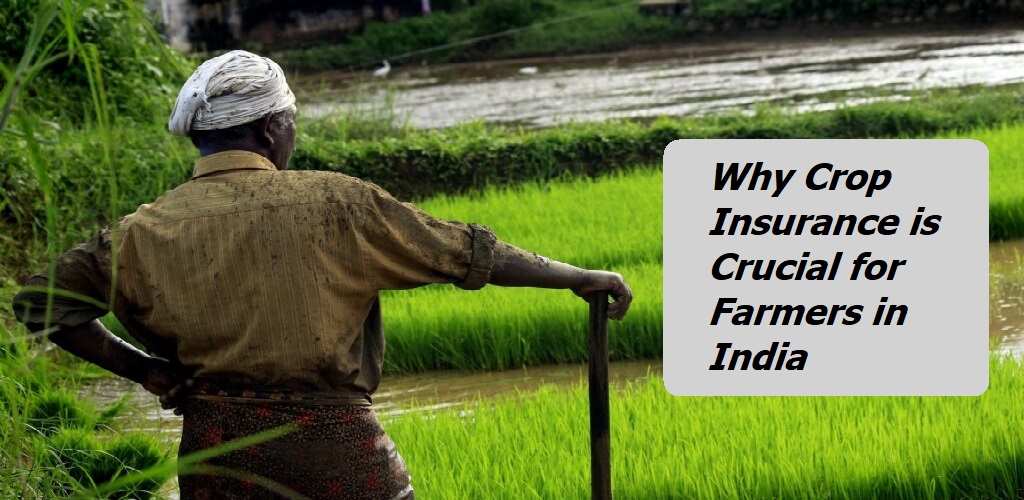Have you ever wondered how much agriculture shapes the Indian economy? With its vast landscapes and millions of farmers, the agriculture sector is the backbone of the country. Yet, farming in India is fraught with challenges. From unpredictable weather to sudden pest invasions, erratic rainfall to humidity spikes—these conditions can devastate crops in an instant, leaving farmers vulnerable. That’s where crop insurance comes into play!
Crop insurance is more than just a financial tool; it’s a lifeline for farmers. It provides coverage for yield losses, shielding them from the crippling effects of disasters like floods, droughts, and storms, as well as market fluctuations. Not only does it help reduce their distress, but also fosters long-term agricultural sustainability. The scheme is designed to mitigate the financial blow of unpredictable risks, which ensures farmers can continue to cultivate and thrive, despite nature’s whims.
What is Crop Insurance?
Crop insurance is an ideal tool for farmers to offer them protection against the financial strain that comes with crop loss. Designed to shield them from the damaging effects of natural disasters, pests, diseases, and other unpredictable events, these plans provide a safety net. With regular premium payments, farmers can rest assured that they will receive financial compensation if their crops are damaged or destroyed.
This protection goes beyond simply covering losses. It enables farmers to recover quickly, which may help them reinvest in their land and continue their agricultural activities without fear of total financial ruin. In doing so, crop insurance strengthens the overall resilience of the farming community, which may ensure that agriculture remains sustainable, even in the face of adversity. Furthermore, this type of security is essential in maintaining not only individual livelihoods but also the stability of the broader agricultural sector.
What Are The Types Of Crop Insurance?
Let’s discuss the types of crop insurance available in the market.
Multiple Peril Crop Insurance (MPCI):
Multiple Peril Crop Insurance (MPCI) is a comprehensive insurance plan designed to protect farmers from a wide range of risks that could result in lower yields or even complete crop failure. This type of insurance covers various natural disasters, such as drought, floods, fires, and destructive weather, as well as damages caused by pests, insects, and diseases. The key feature of MPCI is that it must be purchased before the crop is planted, providing farmers with peace of mind throughout the growing season, knowing they are protected against numerous potential threats.
Actual Production History (APH):
Actual Production History (APH) crop insurance takes into account a farmer’s historical yields over a specific period to assess their overall production levels. The APH is used to calculate an average yield for the farm, which then determines the insurance coverage offered. Farmers with higher yields or more consistent production histories may be offered lower premiums, while those with lower or more erratic yields might face higher premiums. This system ensures that the insurance policy is tailored to the specific risks associated with each farmer’s unique production history, making it a personalized and more equitable form of coverage.
Crop Revenue Coverage:
Crop Revenue Coverage (CRC) helps protect farmers from significant financial losses caused by sudden drops in crop prices or poor yields. With CRC, farmers are safeguarded not only against low production but also against market price volatility. If a farmer’s revenue falls below a certain threshold due to price changes or yield loss, the insurance compensates for the difference, ensuring that they still receive adequate income. This type of coverage is particularly valuable in helping farmers manage their earnings and maintain financial stability even when market conditions are unfavourable.
What Are The Benefits of Crop Insurance For Farmers?
Let’s take a look at the benefits of crop insurance for farmers.
Financial Security for Farmers:
One of the most significant advantages of crop insurance is the financial security it provides to farmers. Farming is inherently risky, with unpredictable weather and market conditions often threatening a farmer’s livelihood. Crop insurance serves as a safety net, offering compensation for losses, which allows farmers to plan their investments and operations with confidence. With this security in place, farmers are more comfortable reinvesting in their land, purchasing essential equipment, and adopting improved farming practices, without the constant worry of financial ruin.
Mitigation of Agricultural Risks:
There is no denying the fact that agriculture is fraught with numerous risks, from natural disasters to pest infestations and plant diseases. Crop insurance plays a critical role in helping farmers manage these uncertainties. With coverage against such diverse risks, crop insurance enables farmers to focus on their farming activities without constantly worrying about potential losses. With the financial burden of unexpected disasters reduced, farmers are empowered to explore new farming techniques, invest in innovations, and experiment with crops and methods that can further improve their productivity and resilience.
Protection Against Natural Disasters:
Another major interesting aspect of crop insurance is that it protects against natural disasters like floods, storms, and droughts. Thus, it aids farmers to recover quickly from disaster-related crop damage or loss. This protection helps minimize disruptions to their farming operations, ensuring that they can move forward with the next planting season and maintain a steady income. In regions prone to extreme weather, crop insurance is especially crucial, offering a much-needed buffer against the high risk of crop failure.
Encouragement of Better Farming Practices:
One of the biggest benefits of Crop insurance is that it offers more than just financial compensation; it also promotes the adoption of better farming practices. Knowing they are protected by insurance, farmers are more likely to invest in high-quality seeds, fertilizers, and advanced agricultural techniques, which leads to improved productivity and higher-quality crops. This investment in better inputs and methods benefits not only individual farmers but also the broader agricultural sector by driving improvements in crop yields and sustainability.
Tailored Insurance Coverage for Farmers:
Lastly, crop insurance policies are highly flexible and offer coverage for a wide range of crops and cater to the specific needs of individual farmers. Whether a farmer operates on a small scale or manages a larger commercial farm, they can find a policy suited to their unique circumstances. This tailored approach ensures that both marginal and commercial farmers receive the appropriate level of protection for their specific farming activities.
What is Included Under Crop Insurance?
Here are the main risks covered by crop insurance plans:
- Basic Coverage
It covers losses to crops caused by unavoidable risks such as diseases, dry spells, landslides, drought, storms, floods, cyclones, hailstorms, or natural fires caused by lightning. It protects standing crops from these unexpected events.
- Prevented Planting Risk
If farmers are unable to sow or plant crops due to bad weather or a lack of rainfall, this insurance covers the financial losses related to these issues.
- Mid-Season Losses
If seasonal conditions are so bad that the crop yield is expected to be less than 50% of normal, the insurance provides relief to farmers.
- Post-Harvest Losses
Crop insurance covers damage to harvested crops for up to two weeks after harvest, which offers protection against unexpected losses during that time.
- Localized Calamities
It also covers damage caused by local disasters, such as landslides or hailstorms, that affect only specific farms in a designated area.
Frequently Asked Questions
Listed below are the frequently asked questions related to crop insurance for farmers in India.
Crop insurance proceeds refer to the payment or financial compensation that a farmer receives from their insurance policy when they file a claim due to crop loss or damage. Once the insurance company verifies the claim, the insured farmer is entitled to these proceeds, which help them recover from financial setbacks caused by the loss of their crops.
Yes, crop insurance can be subsidised by the government under various agricultural schemes. These subsidies reduce the amount farmers need to pay as premiums, making the insurance more affordable. However, in cases where no government subsidies are available, farmers have the option to pay the full premium themselves to obtain crop insurance coverage.
Crop insurance is mandatory for farmers who take crop loans from rural financial institutions. However, other farmers who do not rely on loans can still choose to purchase crop insurance voluntarily for added security.
The government provides crop insurance to support farmers financially in the event of crop failure due to factors like natural disasters, pests, or diseases. With such coverage, the government helps farmers secure their income, reduces financial risks, and encourages them to adopt modern farming practices that can improve productivity.
Yes, one advantage of crop insurance is that the premium farmers pay for their policy is tax-exempt. This enables farmers to deduct the cost of the insurance premium from their taxable income, which may provide them with additional financial relief.








